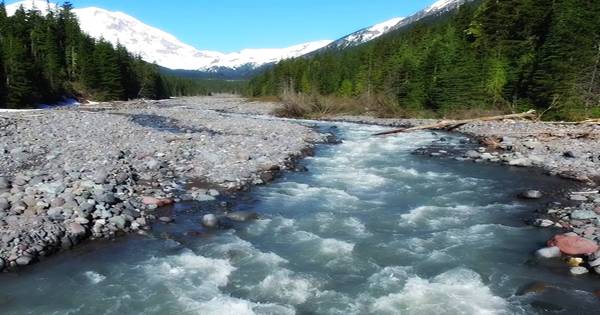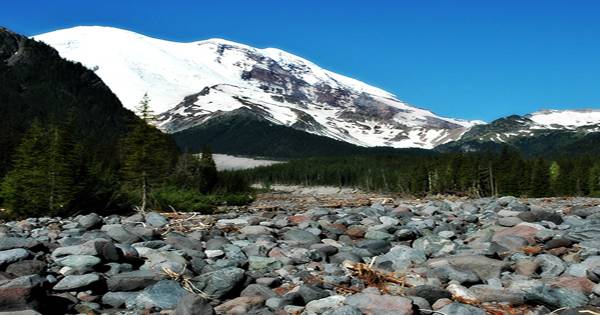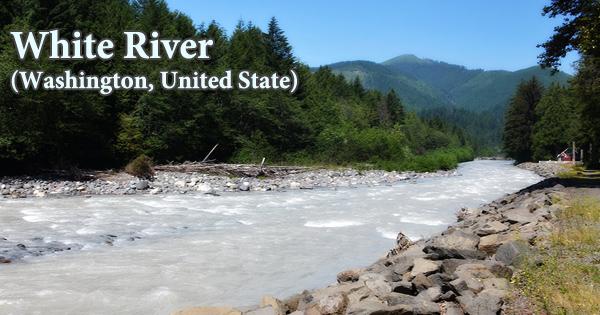The White River is a white, glacial river in Washington, United States. Its waters flow into Puget Sound into a channel 20 miles shorter than the one it followed for centuries. Follow the Puyallup River upstream from Commencement Bay in Puget Sound, much like the hundreds of thousands of pink salmon that migrate in the same waters as endangered chinook, steelhead, and bull trout. The White River flows 75 miles (121 kilometers) from its source on Mount Rainier’s Emmons Glacier to Sumner, where it joins the Puyallup River. It forms part of the county line between King and Pierce.
Until 1906, the stream flowed north into the Green River, then south to the Duwamish and the “salt chuck.” It now empties into the Puyallup River at Sumner, through the Stuck, a river that has officially vanished but whose name is still used by Auburn residents and is commemorated on a state highway bridge. The source of a second White River is in the Glacier Peak Wilderness, and it flows southeast to Lake Wenatchee. The White River, which flows from Mt. Rainier National Park’s Winthrop, Emmons, and Fryingpan glaciers, is one of six river systems that originate from the contiguous United States’ most glaciated peak.

The river flows 68 miles and drains 494 square miles before flowing into the Puyallup River east of Tacoma, starting on the flanks of the famous volcano. The Emmons Glacier on Mount Rainier’s northeast side is the source of the White River. The river originates in ice caves at the glacier’s toe. Mount Rainier National Park covers its upper reaches. The White River flows east after emerging from the Emmons Glacier, passing by the White River Campground and the White River Ranger Station before turning north.
The White River was particularly dangerous, with its deep mountain canyon and drift jams, and farmers despised it. They looked speculatively at the stream’s confluence with the nine-mile-long Stuck River, which flowed into the Puyallup Valley, a few miles southeast of Auburn. Kayakers, anglers, hikers, and tourists to the national park and the surrounding area all appreciate the White River along the way. Four salmon species (chinook, coho, chum, and pink), as well as steelhead and bull trout, call it home. Salmon and steelhead are important to the Muckleshoot and Puyallup Indian tribes’ cultures.

State Route 410, also known as the Mather Memorial Parkway in the national park, runs alongside the White River for most of its upper course. The river leaves Mount Rainier National Park after a few miles and reaches Mount Baker-Snoqualmie National Forest. Settlers were known to have tampered with this natural barrier between the rivers, and according to a government report, “citizen activity largely caused part of the 1892 flood to go down the Stuck Valley.” Mud Mountain Dam impounds the White River, resulting in Mud Mountain Lake, a marshy intermittent lake. The dam was built to prevent flooding. Mud Mountain Lake only fills with water when the stream flow is extraordinarily high.
In the 1940s, the US Army Corps of Engineers constructed Mud Mountain Dam to control flooding. Since the dam prohibits anadromous fish from going through, a “trap and haul” scheme was introduced, in which fish are trucked around the dam. The Buckley Diversion Dam was meant to be the catch-all. Thousands of salmon and steelhead die each year due to the dam’s poor condition and fish collection facilities, particularly during pink salmon runs. Those that do make it into the overcrowded fish trap are often drained, impaled on rebar, or injured as a result of the cramped storage facilities, reducing their chances of spawning after release.
The White River reaches the greater Tacoma metropolitan area below Mud Mountain Dam. It flows between the cities of Buckley and Enumclaw before making a wide bend northwest and then southwest, effectively circumnavigating Lake Tapps. A debris jam in 1906 blocked the White River’s channel, diverting all floodwaters away from King County down the Stuck River and into the Puyallup River. The debris barrier was removed and replaced with a permanent diversion wall at Auburn’s Game Farm Park. The White River is still flowing in this spot today.
White River temperatures are typically in the 70s during the day and in the 50s at night during the season. Winter highs in White River are usually in the 40s, with lows in the 30s on winter nights. White River receives a lot of rain on a regular basis. The wettest month is December, with the most storms, and the driest month is July. A diversion dam near Buckley was constructed in 1911, and it was combined with a system of dikes around the originally small Lake Tapps to create a larger reservoir. A small community has grown up around the lake over time. Around 20 miles (32 km) downstream from the diversion dam, the water from the reservoir is returned to the White River.
Before draining into the Puyallup near Sumner, the White River flows 68 miles and drains 494 square miles. Salmon species such as chinook, pink, chum, and coho, as well as bull, rainbow, steelhead, and coastal cutthroat trout, call the White River and its tributaries home. The runs are dominated by pink and chum salmon. If the greater population of Puget Sound chinook salmon is to recover, the river’s wild spring chinook run must be restored. Despite this, the Corps has taken no measure.
Information Sources:
















